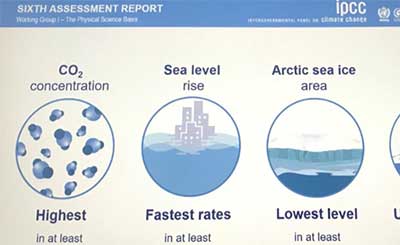GS 2 - Bilateral, regional and global groupings and agreements involving India and/or affecting India’s interests
GS 3 - Food Security
Keywords- FAO, WFP, COP27, CBDR, Climate Justice, Food Security, SDG-1,2, Hidden Hunger, Famine, Adaptation Fund, Paris Pledge
Why in News ?
- The United Nations Special Envoy for Food Systems Summit, has called for an unprecedented focus on food systems — food and agriculture — by ensuring that COP27 (in Egypt) has a dedicated focus on this.
- Recent, UN Food Systems Summit in September, also stressed that global food systems are unequal, strained, or broken as 811 million people are going to bed hungry.
- IPCC 6th report highlighted the looming danger of climate change on Food Security.
Climate change impact on Food Security
- Shrinking Food Basket: climate change impact whole supply chain from production to consumption. It destroys land and crops, kills livestock, depletes fisheries, and cuts off transport to markets. This impacts food production, availability, diversity, access, and safety.
- Increasing Hunger : United Nations World Food Programme (WFP) shows that a 2°C rise in average global temperature from pre-industrial levels will see a staggering 189 million additional people in the grip of hunger.
- Increasing Vulnerability : Majority of communities, who rely on subsistence agriculture, fishing, and livestock, have to bear the impacts of climate change with limited means to adapt.
- Increasing Famine tendencies: Across the world, up to 811 million people do not have enough food and as per the recent WFP estimates, 41 million people in 43 countries are at risk of sliding into famine.
- Increasing Hidden Hunger : Latest IPCC report asserted, climate change threatens nutritional food availability because both crop yield and crop nutritional composition are declining.
About World Food Programme (WFP)
- WFP was founded in 1961 by the Food and Agriculture Organization (FAO) and United Nations General Assembly (UNGA) with its headquarters in Rome, Italy.
- It is a member of the United Nations Sustainable Development Group (UNSDG), a coalition of UN agencies and organizations aimed at fulfilling the Sustainable Development Goals (SDGs).
- The WFP helps nearly 100 countries, and has assisted millions of people to get out of hunger and famine.
Objectives
- WFP focuses on emergency assistance as well as rehabilitation and development aid.
- Two-thirds of its work is in conflict-affected countries.
- The Food and Agriculture Organization (FAO), also helps countries draw up policy and change legislation to support sustainable agriculture
- Also supports countries in the SDG implementation and sharing for best practices.
Role of WFP:
- The WFP is working with communities to adapt to the changing climate that threatens their ability to grow food, secure incomes, and withstand shocks. It has supported 39 governments, helping them realise their national climate ambitions.
- In 2020, the WFP implemented climate risk management solutions in 28 countries, which are now better prepared for climate shocks and stresses and can recover faster.
- In India, the WFP and the Ministry of Environment, Climate Change, and Forestry are planning to develop a best practice model on adaptation and mitigation with potential support from the Adaptation Fund.
Measures need to be taken:
- Creating resilient livelihoods and food security solutions by protecting and improving the livelihood of vulnerable communities.
- The adaptation of climate-resilient food crops, such as millets, for nutritional security.
- Enabling women’s control and ownership of production processes and assets and increased value addition and local solutions.
- Promoting a resilient agriculture sector. This can be done by creating sustainable opportunities, access to finance, and innovation for small-holder farmers, with climate information and preparedness.
- Building capacity and knowledge of civil society and governments for vulnerability analysis. This will increase food security by addressing the link between food security and climate risk.
- Developed countries should fulfill their Paris Pledge of $100 billion annual fund for developing nations.
- Need to follow principles of CBDR, Climate Justice and principles of intergenerational equity in letters and spirits because the very vulnerable-poor countries continue to be hardest hit. The top 10 most food-insecure vulnerable countries contribute only 0.08% of global carbon emissions.
Conclusion
- As said by UN Secretary- General António Guterres. - " Our fragile planet is hanging by a thread... It is time to go into emergency mode — or our chance of reaching net-zero will itself be zero”. Thus, There is a need to reimagine our food systems, and it should be made more resilient to climate change, while making it more green and sustainable, to ensure global achievement of SDG 1(zero poverty) and SDG 2(zero hunger) by 2030.
Prelims Question
Q. With reference to World Food Programme, consider the following statements:
- It is a jointly founded by Food and Agriculture Organization (FAO) and UN-Sustainable Development Group.
- WFP programmes driven by an independent source of funds from UN member states.
Choose the correct option:
A. 1 only
B. 2 only
C. Both 1 and 2
D. Neither 1 nor 2
Answer: D
WFP is a voluntary funded organization, founded by the initiative of FAO and UNGA
Mains Question
Q. Recently, IPCC in its 6th report highlighted the looming danger of climate change on Food Security. In the light of above statement, highlights the significance of WFP in strengthening the food supply chains and ensuring the global co-operation on Food Security. ( 15 marks)
Sources: The Hindu Newspaper









